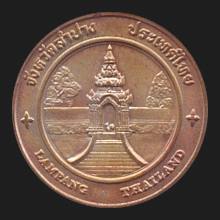|
Lampang (ลำปาง)
Thai. Name of a Thai province as well as its
provincial capital (map) with a population of approximately 43,000,
situated in the broad river valley of the Wang River, in northern Thailand, 599 kms North of
Bangkok.
The city is surrounded by mountain chains and was formerly known by the names
Khelang Nakhon (เขลางค์นคร) and Kukkut Nakhon (กุกกุฎนคร
- the city of cocks). Legend has it that in ancient times a cock was placed at
the city gates, to wake up the
bodisattvas so they could bless
the city and bring
it unremitting honour. Its history dates back nearly 14 centuries, to the
Dvaravati period, and according to legend was founded
in the 7th century by King
Anantayot, the son of
Queen
Chamadevi,
the then ruler of the
Mon kingdom of
Haripunchai,
present-day
Lamphun.
In the 11th century it was occupied by the
Khmer until
1281, when it was recaptured by king
Mengrai,
who soon after made it part of the
Lan Na kingdom. During the
Ayutthaya
Period, when Lan Na was made a vassal from Burma, also Lampang came under
Burmese influence for nearly two hundred years. The city was under Burmese rule from 1614 to
1732, but afterward the area was still affected by the ongoing wars and uproars
between Lan Na and the Burmese until the North was completely liberated with the
re-establishment of
Chiang Mai in 1796. During this period Lampang's architecture was very much influenced by that of Burma, as can still
be seen today, e.g. in Wat Sri Chum,
Wat Phra Kaew Don Tao, etc. In 1732, Pho Chao Thip
Chang (พ่อเจ้าทิพย์ช้าง -
‘Celestial Father Lord of the Elephant’), a local
mahout and
leader from the house of
Thipchakratiwong,
who lived in Ban Pok Yahng Khok (บ้านปกยางคก) in the present-day
amphur Hang Chat, just northwest of the city of Lampang and up to present a
dwelling for mahouts and elephants, organized an uprising against Burmese rule
and finally expelled the foreign occupiers, the first city in Lan Na to
accomplish so in that period. After the victory, he was called upon to become
the new ruler of Lampang and was given the honorary name and title
Phaya
Sulawareuhchai Songkram (สุละวะฤๅไชยสงคราม). His descendants include
Chao Kawila, a
celebrated ruler of Lampang and Chiang Mai and the first king of
Lan Na under
Siamese rule. The city is also known as
‘meuang rot mah’, the city of horse carts (map1,
map2 -
fig.). Among its places of interest are
Wat Phra Kaew Don Tao and
Wat Phrathat Lampang Luang
(fig.). The region is known for its teak industry and the district Hang Chat has a training centre for young elephants.
On national road number one stands a giant
kilometer marker (map
-
fig.).
The province has thirteen amphur.
See also
Lampang data file.
回






|

